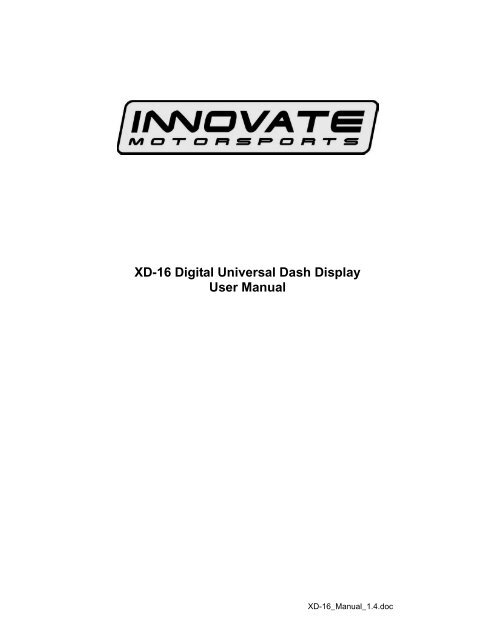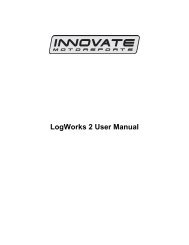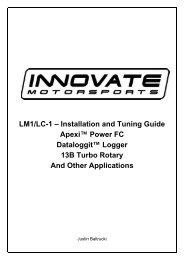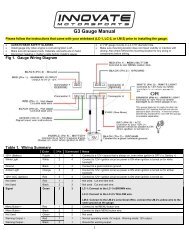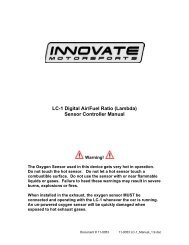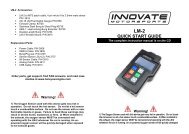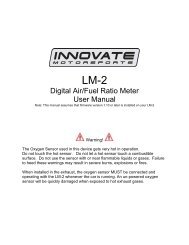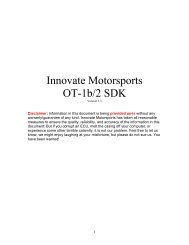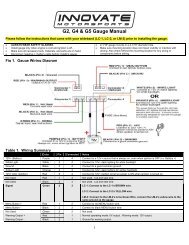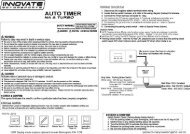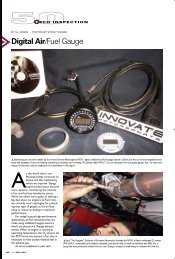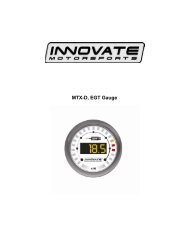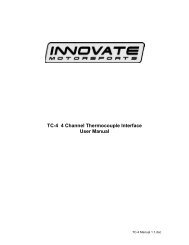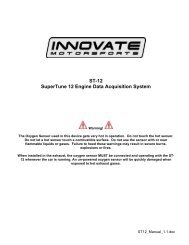XD-16 Manual - Innovate Motorsports
XD-16 Manual - Innovate Motorsports
XD-16 Manual - Innovate Motorsports
Create successful ePaper yourself
Turn your PDF publications into a flip-book with our unique Google optimized e-Paper software.
<strong>XD</strong>-<strong>16</strong> Digital Universal Dash Display<br />
User <strong>Manual</strong><br />
<strong>XD</strong>-<strong>16</strong>_<strong>Manual</strong>_1.4.doc
1. Overview......................................................................................................................................................... 3<br />
2. The <strong>XD</strong>-<strong>16</strong> Device .......................................................................................................................................... 3<br />
The <strong>XD</strong>-<strong>16</strong> Module................................................................................................................................................. 3<br />
2.1. Identifying the user interface features of the <strong>XD</strong>-<strong>16</strong> ................................................................................... 4<br />
3. Mounting and Connecting the <strong>XD</strong>-<strong>16</strong> ............................................................................................................. 4<br />
4. Changing the channel display ........................................................................ Error! Bookmark not defined.<br />
5. Using the <strong>XD</strong>-<strong>16</strong> ............................................................................................................................................. 5<br />
6. Programming the <strong>XD</strong>-<strong>16</strong>................................................................................................................................. 6<br />
6.1. Installing the LM Programmer Software...................................................................................................... 6<br />
6.2. Connecting the <strong>XD</strong>-<strong>16</strong> device to the computer ........................................................................................... 7<br />
6.3. Updating the Firmware................................................................................................................................ 7<br />
6.4. Selecting the display channel ..................................................................................................................... 9<br />
6.5. Programming the Min/Max hold functions ................................................................................................ 10<br />
6.6. Programming the Warning/Alarm function................................................................................................ 11<br />
6.7. Programming the Analog ‘needle’ colors .................................................................................................. 13<br />
7. Changing the gauge face of the <strong>XD</strong>-<strong>16</strong> ........................................................................................................ 14<br />
7.1. Installing the new gauge face ................................................................................................................... 14<br />
7.2. Create a custom label ............................................................................................................................... 15<br />
7.3. Assembly sequence of the <strong>XD</strong>-<strong>16</strong> with foil face........................................................................................ 15<br />
Appendix A: Specifications .................................................................................................................................. 15<br />
Appendix B: Kit Contents ..................................................................................................................................... <strong>16</strong><br />
Appendix C: Limited Warranty ............................................................................................................................ 17<br />
Revision History....................................................................................................................................................... 18<br />
- 2 -
1. Overview<br />
The <strong>XD</strong>-<strong>16</strong> is a programmable digital display used as dash mounted instrument for the <strong>Innovate</strong> <strong>Motorsports</strong><br />
sensor devices. The <strong>XD</strong>-<strong>16</strong> fits into a standard 52mm (2-1/<strong>16</strong>”) gauge hole. Multiple <strong>XD</strong>-<strong>16</strong>’s can be daisychained<br />
to build and entire programmable dash. <strong>XD</strong>-<strong>16</strong> gauge faces can be user customized. The <strong>XD</strong>-<strong>16</strong> can also<br />
be used to initiate and control recording on the LM-1 or other <strong>Innovate</strong> Recording devices, can initiate free air<br />
calibration for <strong>Innovate</strong> <strong>Motorsports</strong> wideband controllers and indicate wideband controller status.<br />
In addition the <strong>XD</strong>-<strong>16</strong> can be programmed to hold minimum/maximum values of the displayed channel and<br />
provide warnings/alerts depending on programmable warn conditions.<br />
2. The <strong>XD</strong>-<strong>16</strong> Device<br />
The <strong>XD</strong>-<strong>16</strong> set contains the following parts:<br />
The <strong>XD</strong>-<strong>16</strong> Module<br />
- 3 -
2.1. Identifying the user interface features of the <strong>XD</strong>-<strong>16</strong><br />
The analog pointer LED’s (21 total) act as a digital needle. The range and individual colors of this “needle” is<br />
freely programmable.<br />
The Function indicators 1 and 2 are used to indicate between % display (heater warm-up or O2 content) when the<br />
<strong>XD</strong>-<strong>16</strong> is programmed as AFR/Lambda display (default). When used to display other channels, the indicators can<br />
be used to indicate the sign of the displayed value. By using the indicators as sign display (positive or negative)<br />
one of the three numerical displays is not wasted to show a ‘-‘ sign. This functionality is programmable.<br />
The main numeric display shows the numeric value of the displayed channel. When the <strong>XD</strong>-<strong>16</strong> is used as<br />
AFR/Lambda display it will also show the status of the wideband controller.<br />
The light sensor allows the <strong>XD</strong>-<strong>16</strong> to adjust its brightness to the light level of the environment. At night the full on<br />
display would be much too bright and would interfere with the operation of the vehicle. During sunlight the <strong>XD</strong>-<strong>16</strong><br />
will go to maximum brightness to allow readability.<br />
The Control Button is used to control various aspects of the <strong>XD</strong>-<strong>16</strong> and attached wideband controller or recording<br />
device like the LM-1.<br />
The record indicator will blink when a LM-1 or other <strong>Innovate</strong> <strong>Motorsports</strong> recording product is attached and<br />
actively recording.<br />
3. Mounting and Connecting the <strong>XD</strong>-<strong>16</strong><br />
1. If not using a commercial gauge pod, cut a 52mm (2 1/<strong>16</strong>”) hole into the intended dash location.<br />
2. Insert and mount the <strong>XD</strong>-<strong>16</strong> and mount it with the included mounting bracket, leaving the <strong>XD</strong>-<strong>16</strong> cables in the<br />
back accessible.<br />
3. Connect the RED wire from the back of the <strong>XD</strong>-<strong>16</strong> to a switched 12V source in your car. A switched 12V<br />
source goes on as soon as the ignition on the car is on or the engine runs. Make sure the connection is fused<br />
with at least a 2A fuse.<br />
4. Connect the BLACK wire to ground. The ground should be shared with other MTS devices (for example: LC-<br />
1, DL-32, SSI-4, TC-4, LMA-3, etc…)<br />
5. Connecting Signal Source:<br />
5.1. If connecting to a LM-1, connect the LM-1 patch cable (P/N: 3759) to the LM-1’s Serial Port. Plug the<br />
2.5mm male stereo end into the <strong>XD</strong>-<strong>16</strong> Serial IN port (female 2.5 mm socket marked “IN”).<br />
5.2. If connecting to an LC-1 or other MTS device, connect the male 2.5mm Stereo to male 2.5mm Stereo<br />
cable between the Serial OUT port of the device to the Serial IN port of the <strong>XD</strong>-<strong>16</strong>. The rule is: LC-1s<br />
first then LMA-3s, SSI-4s, and TC-4s. Then goes the DL-32 which is going to record the information<br />
coming from the other products. Lastly, you connect your <strong>XD</strong>-<strong>16</strong>s which can be setup to display any<br />
channel in the serial chain.<br />
6. If using a computer to datalog or download LM-1 data, connect the <strong>XD</strong>-<strong>16</strong> to Computer cable between the<br />
Serial OUT port of the <strong>XD</strong>-<strong>16</strong> and the computer’s serial port.<br />
The following diagram show how to connect multiple <strong>Innovate</strong> <strong>Motorsports</strong> devices to form a logging and display<br />
chain. The example chain consists of a LM-1, a LC-1, a LMA-3 and 2 <strong>XD</strong>-<strong>16</strong>’s. In this case the chain has 12<br />
channels (6 from LM-1, 1 from LC-1 and 5 from LMA-3). If you are running LC-1s the rule is: LC-1s first then<br />
LMA-3s, SSI-4s, and TC-4s. Then goes the DL-32 which is going to record the information coming from the other<br />
products. Lastly, you connect your <strong>XD</strong>-<strong>16</strong>s which can be setup to display any channel in the serial chain.<br />
- 4 -
4. Using the <strong>XD</strong>-<strong>16</strong><br />
When the <strong>XD</strong>-<strong>16</strong> powers up it will briefly go through a sequence where it lights up all its LEDs. This is a function<br />
and diagnostic test. Holding down the Control button during power-up will continue to light up all LEDs until the<br />
button is released.<br />
4.1. Sensor Warm-up<br />
For example, this would indicate that he heater is warmed up to 56%. The Function Indicator 2 is lit.<br />
4.2. Heater Calibration<br />
The last digit is the count-down of the heater calibration.<br />
4.3. Free air calibration in process<br />
When shown steady, free air calibration is in progress. If blinking and not going away after 5 seconds, the LM-1<br />
requests a free air calibration as happens after a heater calibration.<br />
Blinking CAL can also happen if the control button is pressed rapidly 3 times. Pressing it then again, initiates a<br />
free air calibration. If this is unintentionally pressed, the CAL request goes away after 5 seconds.<br />
4.4. Normal Operation<br />
With function indicator 1 lit this shows AFR.<br />
4.5. Normal Operation very lean mixture or free air<br />
Switching between<br />
and<br />
Shows the free air content of the gas the sensor sees.<br />
4.6. No Connection detected<br />
If the display shows:<br />
The <strong>XD</strong>-<strong>16</strong> cannot receive data from the LM-1 or other devices. Make sure all the connections are fully seated.<br />
4.7. Start/Stop Recording<br />
Press the Control button once to start recording. The Record indicator light will blink.<br />
Press the Control button again once to stop recording. The Record indictor will switch off.<br />
4.8. Clear Recording Memory of LM-1<br />
- 5 -
Press and hold the Control button until<br />
for Reset shows.<br />
4.9. Review Min/Max hold<br />
Press the Control button twice rapidly. The <strong>XD</strong>-<strong>16</strong> will show the last minimum value indicated. Note that the <strong>XD</strong>-<br />
<strong>16</strong> will remember the minimum value even if power is switched off.<br />
Minimum value is indicated by alternating between:<br />
and the minimum value stored.<br />
Holding the Control button down for a few seconds while this is displayed will reset the minimum value.<br />
Press the Control button instead only briefly will show the maximum value indicated. It is indicated by alternating<br />
between:<br />
and the maximum value stored.<br />
Press the Control button again briefly to return to normal operation.<br />
Holding the Control button down for a few seconds while this is displayed will reset the maximum value.<br />
4.10. Initiating a free air calibration<br />
Press the Control button three times rapidly. The display will show a blinking:<br />
If the button was press accidentally three times, wait for 5 seconds. The <strong>XD</strong>-<strong>16</strong> will return to normal display mode.<br />
Pressing the Control button while the blinking CAL is displayed will initiate a free air calibration on ALL connected<br />
wideband devices.<br />
5. Programming the <strong>XD</strong>-<strong>16</strong><br />
You will need:<br />
1. <strong>XD</strong>-<strong>16</strong> to Computer cable (male 2.5mm Stereo to DB-9)<br />
2. <strong>XD</strong>-<strong>16</strong> Terminator plug (single male 2.5mm Stereo plug)<br />
3. A laptop computer<br />
4. When powered by the car, the ignition of the car must be on to power the <strong>XD</strong>-<strong>16</strong>. Alternatively you can power<br />
the <strong>XD</strong>-<strong>16</strong> with a suitable power source between 8V and 25V. A normal 9V battery can be used to power the <strong>XD</strong>-<br />
<strong>16</strong>.<br />
Always disconnect and connected the serial ports labeled IN and OUT with the unit OFF.<br />
5.1. Installing the LM Programmer Software<br />
Put the included CD in your CD-drive on your computer and follow the instructions on screen. The Software will<br />
be installed including pre-set directories for log-data and downloaded software. The LM Installer also puts entries<br />
for the LM Software in the Start-Menu of your computer under the heading ‘<strong>Innovate</strong>!’.<br />
- 6 -
The following items will be installed on your hard-drive<br />
1. LM Programmer<br />
This is used to program the <strong>XD</strong>-<strong>16</strong><br />
2. LogWorks<br />
This is a comprehensive data logging and analysis package to download and analyze engine data<br />
recorded with <strong>Innovate</strong> devices. It also allows real-time logging and display.<br />
LogWorks allows you to program the relationship between sensor voltages recorded by the LM-1 or LMA-<br />
3 and the indicated values. This relationship will be programmed into the <strong>XD</strong>-<strong>16</strong> for the selected<br />
channel/input.<br />
3. <strong>Manual</strong>s<br />
4. Example Log Files<br />
5.2. Connecting the <strong>XD</strong>-<strong>16</strong> device to the computer<br />
1. Connect the Serial OUT connection with the included 2.5mm stereo to DB-9 cable to a serial port on your<br />
laptop.<br />
2. Connect the terminator plug (2.5mm male plug with no cable) into the Serial IN connection of the <strong>XD</strong>-<strong>16</strong>.<br />
Start the LM-Programmer software. The screen should look like this:<br />
5.3. Updating the Firmware<br />
The LM Programmer Info/Set AFR tab reports the firmware version currently installed on your unit. Do not update<br />
the firmware if the versions are the same. A firmware update should only be necessary if there has been a new<br />
release.<br />
- 7 -
Click the 'Update Firmware' in the main page to upgrade to the latest firmware for the LC-1. Firmware for the LC-1<br />
has the extension dld. New firmware releases are available on the <strong>Innovate</strong> <strong>Motorsports</strong>’ web site<br />
(www.tuneyourengine.com) under ‘Support.’<br />
If your computer crashes during a firmware upgrade, the <strong>XD</strong>-<strong>16</strong> has a recovery mechanism where it will be able<br />
to retry the download again and not be disabled by half loaded firmware. Switch the <strong>XD</strong>-<strong>16</strong> off and on again and<br />
then try to restart the LM Manager software. The recovery mechanism is designed to be able to recover 99.9% of<br />
the time. While we don’t anticipate this occurring, it is possible that the <strong>XD</strong>-<strong>16</strong> will not recover correctly and may<br />
need to be serviced at our factory. If you suspect this is the case, contact <strong>Innovate</strong> support.<br />
- 8 -
5.4. Selecting the display channel<br />
1. Prior to selecting a channel to be displayed you must first tell the system what channels are available.<br />
With your MTS chain connected together connect the serial OUT of the last <strong>XD</strong>-<strong>16</strong> to your computer and<br />
launch LogWorks.<br />
2. Make sure that all your channels are setup properly (go into Channels/Configure Channels).<br />
3. Once you have all your gauges setup properly in LogWorks you may exit the application and power the<br />
MTS system down.<br />
4. Remove the <strong>XD</strong>-<strong>16</strong> which you want to reprogram from the MTS serial chain. Insert the terminator plug in<br />
the serial IN of the <strong>XD</strong>-<strong>16</strong> and the cable that goes to the computer to the serial OUT. Launch LM<br />
Programmer.<br />
5. Once in LM Programmer go to the "Input" tab. The LM Programmer will read the MTS record. You will<br />
now be able to select the channel that you want the <strong>XD</strong>-<strong>16</strong> to display.<br />
If you select something other than a Lambda/AFR channel, the display will change to:<br />
As you can see here, the display will indicate in 100 RPM. This might be too coarse for many applications. The<br />
limit is there because the <strong>XD</strong>-<strong>16</strong> can only display 3 digits. By applying a limit (for example to 0…9990 RPM the<br />
- 9 -
<strong>XD</strong>-<strong>16</strong> can display the RPM in multiples of 10 RPM. If a channel is selected that has both positive and negative<br />
values, a different screen will show:<br />
This allows you to use the Indicator 1 and 2 LEDs as negative value indicators to preserve the 3-digit resolution of<br />
the <strong>XD</strong>-<strong>16</strong>.<br />
6. Once programmed, power off the <strong>XD</strong>-<strong>16</strong> and exit LM Programmer. Reconnect the <strong>XD</strong>-<strong>16</strong> to your MTS<br />
chain.<br />
Note: The <strong>XD</strong>-<strong>16</strong> comes preprogrammed to display A/F. If you have multiple A/F channels the unit will<br />
display the first one on the chain.<br />
5.5. Programming the Min/Max hold functions<br />
Click on the Min. Hold or Max. Hold Tab on the top of the window. The following screen will show up:<br />
- 10 -
Programming the Min or Max hold function should be pretty self evident. You can enable the function. You can<br />
also make the hold function depending on another channel. In this example the Max hold function will be<br />
programmed so that the leanest AFR is only stored during WOT operation and only if the condition persists for<br />
more than 0.2 seconds. In this case AFR was used as input and you don’t want to store the leanest AFR during<br />
closed throttle where the injectors cut off. Any channel can be programmed as dependency. You can program<br />
any minimum persist time between 0 and 10 seconds.<br />
5.6. Programming the Warning/Alarm function<br />
Click on the Alarm tab on the top of the screen.<br />
- 11 -
Again, the programming is very similar to the Min/Max hold programming as described in 4.6.<br />
Except here the Alarm condition can be programmed to be dependent on two other channels and time.<br />
During an Alarm the <strong>XD</strong>-<strong>16</strong> will flash the indicated value and the analog needle LEDs at maximum brightness until<br />
the Alarm condition goes away.<br />
- 12 -
5.7. Programming the Analog ‘needle’ colors<br />
Click on the Colors tab.<br />
This shows the current color settings for all the 21 LEDs plus the indicator colors used when reviewing Min/Max<br />
hold.<br />
To change the color of an individual LED, double-click with your mouse on the LED to change. The following<br />
dialog box will show up:<br />
The currently selected LED is also highlighted.<br />
By changing the sliders for red, green and blue any color out of a set of 32767 colors can be created. Any color<br />
can be created by mixing red, green and blue light at varying ratios. The <strong>XD</strong>-<strong>16</strong> can be programmed for 32<br />
different values for each red, green and blue. And 32x32x32 is 32768. But black (all off) is hardly used.<br />
While moving the sliders the simulated LED on the screen changes color and also the appropriate LED on the<br />
<strong>XD</strong>-<strong>16</strong> at the same time. Because computer screens use a different technology to create colors than the <strong>XD</strong>-<strong>16</strong>,<br />
the actual colors on the <strong>XD</strong>-<strong>16</strong> can be different than the screen colors.<br />
With the sweep test button the <strong>XD</strong>-<strong>16</strong> will sweep through all LEDs from left to right to give you and indication on<br />
how the color scheme you programmed will look in real life.<br />
To change multiple LEDs to the same color, just program one LED. Then drag this LED over the other LEDs you<br />
want to program to the same color.<br />
- 13 -
6. Changing the gauge face of the <strong>XD</strong>-<strong>16</strong><br />
When you use the <strong>XD</strong>-<strong>16</strong> to display different channels than AFR or Lambda, you very likely want to change the<br />
gauge face. As the LM-1/MTS system can be programmed for any 0..5V sensor, the possibilities are endless.<br />
Because not every possible use can be anticipated, the <strong>XD</strong>-<strong>16</strong> is designed to allow user customization.<br />
6.1. Installing the new gauge face<br />
1. Lay the <strong>XD</strong>-<strong>16</strong> face down on a table and remove the three Phillips screws from the outside rim of the<br />
back plate.<br />
2. Carefully lift out the back plate with the electronics package from the bezel.<br />
3. Laying the electronics package on its back, first place the gauge face followed the glass and bezel. *Be<br />
sure to remove protective film from the gauge face. This can be done easily with a piece of scotch<br />
tape. Make sure every piece is positioned correctly on the button shaft.<br />
4. Carefully flip the complete assembly and line up the screw hole of the bezel with the screw hole of the<br />
back plate ensuring that everything slides into the bezel correctly.<br />
5. Holding the assembly together with one hand, test the operation of the button and as necessary, adjust<br />
by rotating bezel, glass, and gauge face.<br />
6. Reinstall the 3 Phillips screws.<br />
- 14 -
6.2. Create a custom label<br />
Note:<br />
To customize you will need to use a blank white gauge face (supplied with every <strong>XD</strong>-<strong>16</strong>).<br />
<strong>Innovate</strong> <strong>Motorsports</strong> will provide downloadable .pdf file templates for the most common sensors at:<br />
www.innovatemotorsports.com.<br />
Print these templates on clear overhead foil suitable for your printer. Any stationary store carries those.<br />
Depending whether you use an inkjet or laser printer, different foils will be needed.<br />
1. Exacto TM knife or razor blade (or scissors)<br />
2. Piece of plywood or sturdy cardboard as cutting background. (Do not use the kitchen table).<br />
3. A 1/8” hole punch. Leather equipment stores or horse tack stores carry those.<br />
4. A small Phillips screw-driver.<br />
5. Blank white <strong>XD</strong>-<strong>16</strong> face (included)<br />
6.3. Assembly sequence of the <strong>XD</strong>-<strong>16</strong> with foil face<br />
Appendix A: Specifications<br />
Supply voltage range 8V to 25V<br />
Current draw < 600 mA *<br />
Weight<br />
3oz / 82g<br />
Serial port speed<br />
19.2 kb<br />
Max serial port cable length 15 ft.<br />
*Current draw depends on outside brightness and number of LED segments lit.<br />
- 15 -
Appendix B: Kit Contents<br />
Standalone Gauge Kit (P/N: 3781) - As Shown below<br />
<strong>XD</strong>-<strong>16</strong> Kit (P/N: 3780) – Excludes LC-1, Sensor (P/N: 3737), and Bung/Plug (P/N: 3735). Includes patch cable for<br />
LM-1 (P/N: 3759) – see below)<br />
Gauge Face Kit<br />
2.5 to 2.5 Daisy-Chain<br />
Cable (P/N: 3760)<br />
Bezel<br />
Sensor (P/N: 3737)<br />
<strong>XD</strong>-<strong>16</strong> Hardware Kit<br />
(P/N: 3770)<br />
Program Cable (P/N: 3746)<br />
LC-1<br />
<strong>XD</strong>-<strong>16</strong><br />
Quick Start Guide<br />
Bung/Plug (P/N: 3735)<br />
Terminator Plug (P/N: 3750)<br />
LM-1 patch cable ((P/N: 3759) – included in kit 3780<br />
- <strong>16</strong> -
Appendix C: Limited Warranty<br />
LIMITED WARRANTY<br />
<strong>Innovate</strong> stands behind the quality of its products. <strong>Innovate</strong> makes the following warranty to purchasers of its<br />
products: All new <strong>Innovate</strong> products carry a six-month warranty from the date of purchase. If proof of purchase<br />
cannot be provided, warranty will be determined by date of manufacture.<br />
When Warranty Void<br />
This warranty shall terminate and <strong>Innovate</strong> shall have no obligation pursuant to it if (i) your <strong>Innovate</strong> product has<br />
been modified or repaired in a manner not previously authorized by <strong>Innovate</strong> in writing, (ii) the identification<br />
markings on your <strong>Innovate</strong> product have been removed, defaced, or altered; (iii) your <strong>Innovate</strong> product was<br />
subjected to accident, abuse, shipping damage, or improper use; (iv) your <strong>Innovate</strong> product was not used or<br />
configured as specified in the product manual; or (v) your <strong>Innovate</strong> product was subjected to operating conditions<br />
more severe than those specified in the product manual.<br />
Exclusions From This Warranty<br />
Oxygen Sensors are excluded from this warranty.<br />
Repairs Under This Warranty<br />
In the unlikely event that your <strong>Innovate</strong> hardware product should prove defective during the warranty period,<br />
contact <strong>Innovate</strong> Customer Support for a return material authorization (RMA) at 949-502-8400. Products returned<br />
for service must be securely packed to prevent damage and shipped charges pre paid, along with proof of<br />
purchase and the return material authorization number, to the <strong>Innovate</strong> repair location as instructed by Customer<br />
Service. <strong>Innovate</strong> within a reasonable amount of time from its receipt of your product so shipped, will ship to you,<br />
at its option, the repaired product or a new or reconditioned product of comparable or greater specified<br />
functionality. All repaired or replacement products shall be warranted for the remainder of the original product<br />
warranty.<br />
Disclaimer<br />
INNOVATE MAKES NO OTHER EXPRESS OR IMPLIED WARRANTY WITH RESPECT TO YOUR INNOVATE<br />
PRODUCT OTHER THAN THE LIMITED WARRANTY SET FORTH ABOVE. No <strong>Innovate</strong> dealer, agent, or<br />
employee is authorized to make any modification, extension, or addition to this warranty, unless enforceable or<br />
unlawful under applicable law, INNOVATE DISCLAIMS ALL IMPLIED WARRANTIES, INCLUDING THE IMPLIED<br />
WARRANTIES OF MERCHANTABILITY, NONINFRINGEMENT, AND FITNESS FOR A PARTICULAR<br />
PURPOSE, AND THE LIABILITY OF INNOVATE, IF ANY, FOR DAMAGES RELATING TO ANY ALLEGEDLY<br />
DEFECTIVE PRODUCT SHALL UNDER ANY TORT, CONTRACT, OR OTHER LEGAL THEORY BE LIMITED<br />
TO THE ACTUAL PRICE PAID FOR SUCH PRODUCT AND SHALL IN NO EVENT INCLUDE INCIDENTAL,<br />
CONSEQUENTIAL, SPECIAL, OR INDIRECT DAMAGES OF ANY KIND EVEN IF INNOVATE IS AWARE OF<br />
THE POSSIBILITY OF SUCH DAMAGES. Some states do not allow limitations on how long an implied warranty<br />
lasts or the exclusion or limitation of incidental or consequential damages, so the above limitations or exclusions<br />
may not apply to you.<br />
- 17 -
Revision History<br />
1.0 – 2/5/05<br />
Initial release<br />
1.1- 3/<strong>16</strong>/05<br />
Corrected misc. errata.<br />
1.2- 4/11/05<br />
Corrected section 2.2<br />
1.3 – 2/06/06<br />
Added <strong>XD</strong>-<strong>16</strong> information<br />
1.4 – 08/23/07<br />
Added Appendix B: Kit Contents<br />
- 18 -


